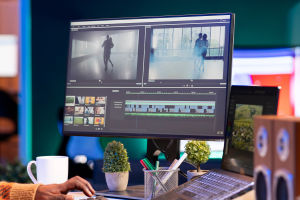Have you ever dreamed of stepping inside a movie rather than just watching it unfold on screen? With the rise of Virtual Reality (VR) technology, that dream is quickly becoming a reality.
Let's dive into how VR is reshaping cinema, offering audiences an entirely new way to engage with stories, characters, and worlds—one immersive step at a time.
What Is Virtual Reality Cinema?
Virtual Reality cinema, often referred to as VR cinema or immersive storytelling, blends traditional filmmaking techniques with interactive, 360-degree environments. Instead of sitting back and watching a screen, the viewer wears a headset and enters a three-dimensional world where they can look around, move, and sometimes even interact with the environment.
Unlike standard films, VR cinema places the viewer at the center of the narrative. You are not just watching the characters—you are in the room with them. This revolutionizes the relationship between the audience and the story, making every viewing session a deeply personal experience.
The Evolution from Passive to Active Viewing
Traditional cinema has always been a passive experience. You watch, you listen, and you feel—but you don't influence the events. VR flips that model. While many VR films still follow a scripted path, the viewer's perspective becomes crucial. Where you look, when you turn, and even your virtual position in a room can affect how the story unfolds.
This active participation creates a powerful emotional connection. For instance, if a character walks up to you in VR and speaks directly, you feel involved in a way that standard films can't replicate. It's not just about storytelling anymore—it's about story experiencing.
New Possibilities for Storytellers
Directors and writers now have a new playground. In VR, the viewer's attention can shift in any direction. That means the narrative structure must adapt. Directors can't rely solely on camera cuts or zooms—they need to use lighting, sound, and motion to guide the viewer's focus.
Some creators experiment with branching narratives, where viewer choices influence the outcome. Others design 360-degree environments with layered details, encouraging multiple viewings to catch everything. This opens doors to complex, nonlinear storytelling—much like exploring a digital world in a video game, but with cinematic depth and artistic control.
Real-World Examples and Pioneers
Several groundbreaking projects have highlighted the power of VR cinema. Viewers have been transported into immersive, emotionally charged experiences that bring unique human stories to life in ways traditional film cannot.
The medium has even garnered recognition from major award bodies, marking a significant step forward for immersive storytelling. From futuristic adventures to deeply personal documentaries, VR cinema is gaining traction and becoming an integral part of modern film culture.
The Technology Behind the Experience
VR cinema requires a combination of 360-degree video capture, CGI environments, spatial audio, and powerful headsets. Some cameras capture spherical footage, while game engines help create interactive scenes.
Audio plays a critical role too. Spatial or binaural sound ensures that what you hear matches what you see—when a sound comes from behind, it truly feels like it's behind you. These technologies work together to create an environment that mimics real-life perception.
Challenges Faced by VR Filmmakers
While the potential is exciting, VR filmmaking is not without its challenges. First, it's expensive. The hardware and software needed to create and view VR experiences are still costly for many independent creators.
Second, there are technical and storytelling limitations. It's difficult to frame a shot or direct viewer attention without traditional cinematic tools. Additionally, motion sickness is a real concern; if the frame rate drops or movement feels unnatural, the viewer can become uncomfortable.
Filmmakers must also contend with the shorter attention span common in interactive media. Many VR films are under 20 minutes long to ensure that viewers remain fully engaged and avoid fatigue.
Will VR Replace Traditional Movies?
The short answer: unlikely. VR is not here to replace cinema, but to expand its possibilities. Just as streaming didn't eliminate movie theaters, VR will likely find its own niche. It's best suited for experiential storytelling, educational content, and emotional immersion.
That said, younger audiences, especially Gen Z and Gen Alpha, are growing up with VR as a norm. As the technology becomes more affordable and content grows in quality and quantity, it may become a regular option alongside traditional cinema and streaming platforms.
VR Cinema at Home
With consumer headsets becoming more accessible, viewers can now enjoy VR cinema at home. Many platforms offer a wide range of immersive films and documentaries.
This accessibility is especially important in a world where home entertainment is growing rapidly. It allows audiences to enjoy immersive experiences without needing to visit a physical theater or exhibition space.
The Future: AI and Interactive Stories
As artificial intelligence improves, we may see AI-powered characters and adaptive storylines. Imagine a VR film where the characters react to your emotions or dialogue choices. Already, tools like ChatGPT are being integrated into interactive media to create more personalized and responsive narratives.
Future VR films may also incorporate augmented reality (AR) elements, blending the digital world with the viewer's physical space. This could create layered experiences that mix storytelling, art, and real-world interaction.
Conclusion: A Bold New Chapter
Virtual Reality is opening a new chapter in the history of cinema. By turning passive viewers into active participants, VR is not just changing how stories are told—it's changing how stories are felt. With ongoing innovation, passionate creators, and increasing accessibility, VR cinema is set to become a vital part of the entertainment landscape.
So, would you step inside a movie if you had the chance? Whether it's to explore a distant planet, walk through history, or feel a character's journey as your own, VR cinema invites you to go beyond the screen—and enter the scene.


